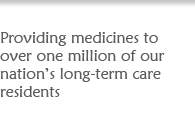|
The LTCPA Institutional Pharmacy
Dispensing Cost Study
Conducted by BDO Seidman, LLP
April 2002
Executive Summary
Pharmacies that serve institutional sites of care, such as nursing homes, have higher costs of doing business than other pharmacies. To quantify this phenomenon, the Long Term Care Pharmacy Alliance - an organization representing the major national operators of long-term care pharmacies - commissioned the accounting firm of BDO Seidman to conduct a survey of its members' dispensing costs, consolidate the financial information, and issue a report on the costs of dispensing pharmaceuticals to residents in nursing homes and other long-term care sites.
The BDO Seidman survey found that it costs the major national operators of long-term care pharmacies, on average, approximately $11.37 to dispense a prescription. This figure does not include a return on equity or a profit margin - it simply reflects the costs of operating a long-term care pharmacy.
In contrast, the National Association of Chain Drug Stores (NACDS) estimated in 2000 that it costs a chain pharmacy, on average, $7.05 to dispense a prescription to a retail customer.
In reviewing the survey results, BDO Seidman found several reasons why the costs of dispensing prescriptions are higher for long-term care pharmacies than they are for retail pharmacies. BDO Seidman attributed the higher costs to:
- the dispensing of drugs in specialized packaging systems, such as unit-dose packaging, that reduce the possibility of medication errors and are the standard of care in nursing homes;
- the need for round-the-clock delivery of critical and emergency medications to meet long-term care regulatory requirements;
- the preparation and dispensing of intravenous medication solutions, a service that retail pharmacies typically do not provide;
- a high percentage of business reimbursed by Medicare and Medicaid, resulting in higher receivables, greater working capital requirements, and a higher percentage of bad debts than generally experienced in the retail setting; and
- the provision of considerable on-site support and consultation to nursing homes and other institutional provider-clients.
|


